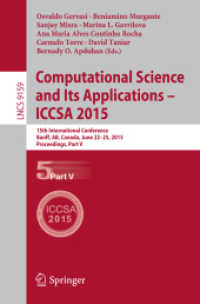基本説明
Utilizing cartoons and jokes illustrating linguistic concepts, this book makes it easy to understand these concepts, while keeping the reader's attention and interest. Organized like a course textbook in linguistics, it covers all the major topics in a typical linguistics survey course, including communication systems, phonetics and phonology, morphemes, words, phrases, sentences, language use, discourses, child language acquisition and language variation, while avoiding technical terminology.
Full Description
Students often struggle to understand linguistic concepts through examples of language data provided in class or in texts. Presented with ambiguous information, students frequently respond that they do not 'get it'. The solution is to find an example of humour that relies on the targeted ambiguity. Once they laugh at the joke, they have tacitly understood the concept, and then it is only a matter of explaining why they found it funny. Utilizing cartoons and jokes illustrating linguistic concepts, this book makes it easy to understand these concepts, while keeping the reader's attention and interest. Organized like a course textbook in linguistics, it covers all the major topics in a typical linguistics survey course, including communication systems, phonetics and phonology, morphemes, words, phrases, sentences, language use, discourses, child language acquisition and language variation, while avoiding technical terminology.
Contents
1. Introduction; 2. Talking to Garfield: human and animal communication; 3. Did I hear that right? The sounds of language; 4. Twisted words: word structure and meaning; 5. Fitting words together: phrase structure and meaning; 6. Meaning one thing and saying another: indirect speech and conversational principles; 7. Fitting the pieces together: the structure of discourse; 8. 'Kids say the darndest things': children acquiring language; 9. Variety is the spice of life: language variation; 10. Cross-cultural gaffes: language and culture; 11. The language police: prescriptivism and standardization; 12. So long, and thanks for all the fish.








